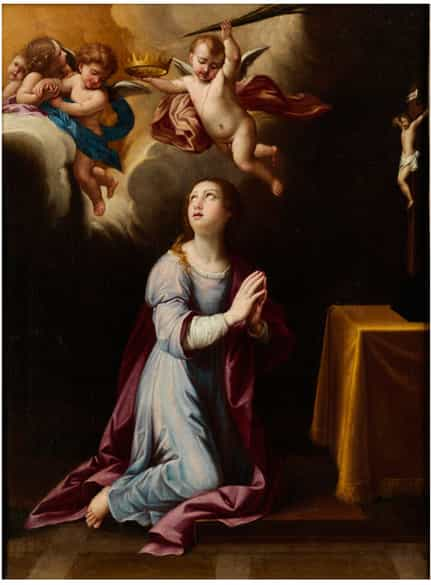Auction 16th - 18th Century Paintings
» reset
Your personal art agent

You are interested in works by Giovanni Battista Salvi?
We are happy to inform you, if works by Giovanni Battista Salvi are to be auctioned in one of our upcoming auctions.
Please accept our privacy policy
403
Giovanni Battista Salvi,
genannt Il Sassoferrato,
1609 Rom - 1685
HEILIGE MÄRTYRERIN IN EKSTASE Öl auf Leinwand.
49 x 36 cm.
Catalogue price € 30.000 - 50.000
Catalogue price€ 30.000 - 50.000
$ 32,400 - 54,000
£ 27,000 - 45,000
元 234,600 - 391,000
₽ 2,984,700 - 4,974,500
Dem Gemälde sind Expertisen von Filippo Todini, datiert 20. November 1990, und von François Macé de Lépinay, vom 30.09.1992, beigegeben.
Dieses kleinformatige Gemälde zeigt eine Frau, die vor einem Kreuz kniet und betet. Ihre ganze Aufmerksamkeit gilt einer Himmelserscheinung, einer Gruppe von vier Engeln, von denen einer eine Krone und die Märtyrerpalme in den Händen hält. An diesem Attribut erkennt man, dass es sich hier um eine Märtyrerheilige handelt, auch wenn weitere Attribute fehlen, an Hand derer man erkennen könnte, um welche Heilige es sich handelt. Vormals wurde dieses Gemälde Domenichino zugeschrieben. Dann erkannten jedoch Filippo Todini und François Macé de Lépinay die elegante und ausgewogene Bildaufteilung, die lackartig glänzenden Farben mit jenen typischen schrillen Rot- und Blautönen wieder, die eindeutig zu Sassoferrato gehören. Hierbei handelt es sich um jene klassische „neo-raphaelitisch, fast puristische“ Ausdrucksweise (Todini), die jedoch, in Anlehnung an die Grundmodelle von Guido Reni, seitens des Künstlers neu interpretiert wird.
Vor allem die Heilige selbst erinnert an die Maria der „Annunciazione“ von Reni, die dieser gegen Ende der dritten Dekade für die Kirche Santa Maria della Carità in Ascoli Piceno malte (heute zu sehen in der dortigen Pinacoteca Civica). Auf diesem Gemälde erkennt man den gleichen Boden im Schachbrettmuster. Der Tisch mit dem Kreuz erinnert hingegen an „Sant‘Andrea Corsini“, auch dies ein Werk, das Guido Reni gegen 1630 malte (vormals zu sehen in der Galleria Corsini in Florenz und heute in den Uffizien). Auch die Engel verweisen eindeutig auf die Bologneser Schule, hier besonders auf Domenichino, der Sassoferratos erster Lehrer in Rom war. Eine weitere Inspirationsquelle für den Tisch mit dem Kruzifix dürfte ein Kupferstich des „Heiligen Antonius von Padua“ (1637) von Giovanni Battista Mercati gewesen sein, der ebenfalls ein Anhänger Dominichinos war und in Rom zum Kreis der Barberini gehörte.
Das vorliegende Gemälde ist innerhalb des Werkkatalogs von Sassoferrato ikonografisch ungewöhnlich. Wahrscheinlich entstand es um 1640, etwa zur gleichen Zeit des Gemäldes von 1641 in der Decke der Sakristei der Kirche San Francesco di Paola in Rom und dessen signierter Wiederholung, die heute in der Nationalgalerie in Prag zu sehen ist. Hervorzuheben sind vor allem der bereits voll ausgereifte Stil und die Poesie Sassoferratos, die unverwechselbare Feinheit und Zartheit der Formen und die wohlüberlegte klassizistische Perfektion, eben jene Ideale, die im Laufe der Jahre zum bleibenden Merkmal seines Stils wurden. (1021643) (21)
Giovanni Battista Salvi, also known as “Il Sassoferrato”,
1609 Rome – 1685
THE ECSTASY OF A SACRED FEMALE MARTYR
Oil on canvas.
49 x 36 cm.
Accompanied by two expert’s reports from Filippo Todini, dated 20 November 1990, and François Macé de Lépinay, dated 30/9/1992.
This small format painting shows a woman kneeling in front of a cross in prayer. This painting was previously attributed to Domenichino. However, Filippo Todini and François Macé de Lépinay re-attributed it to Sassoferrato on stylistic grounds, based on the work’s elegant and balanced composition, the shiny lacquer-like colours with those typical loud hues of red and blue. Based on the newly interpreted prototypes of Guido Reni, the artist has created this classic “neo-Raphaelite, almost “puristic” style (Todini).
The present painting’s iconography is unusual for Sassoferrato’s oeuvre. It was probably created in ca. 1640, approximately around the same time the painting for the ceiling of the vestry of the San Francesco di Paola Church in Rome was created in 1641 and its signed copy, today held at the National Gallery in Prague. Above all Sassoferrato’s fully matured style and poetry should be pointed out, the distinctive subtlety and delicateness of the forms and carefully considered classical perfection – those ideals which became, over time, permanent characteristics of his style.
This object has been individually compared to the information in the Art Loss Register data bank and is not registered there as stolen or missing.
Your personal art agent
You would like to be informed of upcoming auctions if a work by Giovanni Battista Salvi is offered? Activate your personal art agent here.
Please accept our privacy policy
You would like to purchase a work by Giovanni Battista Salvi?
Your personal art agent Purchase in Private Sale Calendar
Our experts are happy to support you personally in your search for art objects.
You would like to sell a work by Giovanni Battista Salvi?
Consign now Private Sale Service FAQ
Your consignments are always welcome.
Our staff will be happy to personally assist you every step of the way. We look forward to your call.
Get in touch with our experts
further catalogues Furniture & Interior | Works of Art, Miniature Furniture, Silver, Maiolica and Russian Art | Asian Art | 19th - 20th Century Paintings | 16th - 18th Century Paintings | Luxury auction: Hermès, Louis Vuitton | Luxury auction: Jewellery | Luxury auction: Wrist watches | Modern Art | Napoleonica The Jürgen Kattwinkel collection pt 1 | Hampel Living












